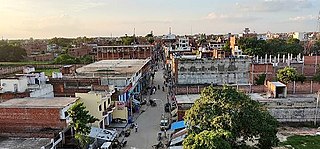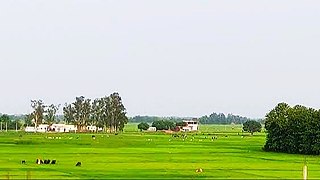
Ghazipur district is a district of Uttar Pradesh state in northern India. The city of Ghazipur is the district headquarters. The district is part of Varanasi Division. The region of Ghazipur is famous mainly for the production of its unique rose-scented Spray called Gulab Jal, and for the tomb of the Governor General of British India, Lord Cornwallis, who died here. His tomb is situated in Western part of City, and is conserved by Archaeological Survey of India.
Zamania is a town in the Indian state of Uttar Pradesh. Its municipal council is subordinate to the Ghazipur District. It is also the administrative head of Zamania tehsil,. It is also a very historical town, it derives its name from Ali Quli Khan Zaman, who was also known as Khan Zaman or Zaman Khan, he was a governor of Jaunpur, and Ghazipur during the time of Akbar.
Gahmar is a village in India, located near the Ganges river in the Ghazipur district in the state of Uttar Pradesh. The village is 38 km from Ghazipur. The village has two post offices, and one Panchayat Bhawan. Gahmar is also known as the "Village of Soldiers". The Gahmar village is also recognised as the most populated or among the most populated villages in India.
The Great Sherpur is a region or a pargana of 'Shankarwar Vansh' in the Mohammadabad tehsil of Ghazipur district in Uttar Pradesh. It consists of Sherpur Kalan, Sherpur Khurd, Semra, Firozpur, villages which were established by the descendants of Dullah Rai. It has population of 31322 as per 2011 Census.
Suhwal is a village of Ghazipur district under Reotipur block. It is situated on Ghazipur to Buxar Road 8 km (5 mi) from Ghazipur City. Its population is 10,814. The Village is quite old. It has its own local administration under the Panchayati Raj system, with Gram Pradhan as head of local administration. There are two Government Secondary Schools, three Government Primary Schools and some privately run Schools. There is a small permanent Market in the western side of the Village and also a weekly Market. Suhwal is a center of Shopping and Primary Education for many other small villages situated on its fringe.

Dildarnagar Kamsar is a pargana (region) and a mashra comprising 34 settlements located around the Karamnasa River in the Ghazipur district of Uttar Pradesh and the Kaimur district of Bihar, India. Of these, 18 mouzas are the primary settlements. It is a prominent settlement of Khanzadas, also known as Kamsari Pathans, as well as Afghan Pathans, primarily of the Niazi and Yusufzai clans. The original name of the region was Kamsar, but due to close and historical ties with the family of Bara Pathans, the region is often referred to as Kamsar-O-Bar. It was established in 1542 by Raja Narhar Khan.

Usia is a village in Kamsaar, Uttar Pradesh, India. It is located southeast of Ghazipur and east of Dildarnagar, near the Bihar State border. The village has a population of 24,786 residents living in 3,471 households. Usia is approximately 7 km from Dildarnagar. Around 8500 Kamsar Pathans lived here as of 2011.
Fufuao or Rampur Phuphuaon is a village in Dildarnagar Kamsar in the Indian state of Uttar Pradesh.
Jevpur is a village located near the Ganga (Ganges) River in Uttar Pradesh, India. It comes under the Ghazipur (Loksabha) Parliamentary Constituency and the Zamania Legislative Assembly. It is about 8 kilometres (5.0 mi) distance from the town of Zamania, about 16 kilometres (9.9 mi) approx distance from Ghazipur, and 337 kilometres (209 mi) distant from Lucknow. The Ganga is on the village's western side and on its eastern side is a shrine to Shiva, locally called Maheshwar Nath Baba.
Gaighat is an Indian village in the town of Zamania within the Ghazipur district of Uttar Pradesh.
Kundesar is a village in Ghazipur district, Uttar Pradesh. It has a population of 4602 according to the 2011 Census. Having a history of five hundred years, this village has rich heritage of the Kinwar clan. Kundesar has had special mention in the gazettes of Ghazipur since 1781. Kundesar is situated on the Ghazipur–Patna National Highway 19.
Mahārāja Kam Dév Singh Urf Rao Dalpat Karam Singh (1438–1532) was a Sikarwar Bhumeehar, king of the Kanyakubja Gotra and belonged to Sikri dynasty, which ruled over the region of Fatehpur Sikri and then Fatuhabad near Fatehpur. He was ruler of the Pahargarh Estate, which mainly comprised what are now the cities of Morena, Gwalior, Jhansi, and Shivpuri, in old Rajputana region. Kam Dev was the son of Maharaja Jay Raj Dev Singh who was the ruler of the Vijaypur Sikri state. With this Kam Dev and Dham Dev were an ally of Rana Sanga.
Sihani is a village in Kamsaar, in Ghazipur district, Uttar Pradesh, India. As of 2011 census the main population of the village lived in 18.7 acres and had 220 households.
Seorai is a village of Dildarnagar Kamsar, and also serve as the headquarters of SeoraiTahsil in region of Ghazipur District of Uttar Pradesh, India. The Seorai tehsil was made a tehsil of the Ghazipur District in year 2016. It consists of 142 villages and one town. Seorai main village has a total area of 878.02 hectares and a population of 20000 but its total area is 1,082.83 hectares and a population of 20,530 which also includes Bhadaura. Seorai tehsil has the total area of 366.62 km2 (141.55 sq mi). Seorai also served as the capital of Kamsaar estate from late 1500s to mid 1600s.
Nawali is a village in Seorai tehsil of Ghazipur District, Uttar Pradesh, India.
Mednipur is the largest village by area in Zamania tehsil of Ghazipur District, Uttar Pradesh, India. There are two more villages along, one Kalupr and second Tari or Tarighat. All three are separate panchayats.

Zamania Canal is one of the largest canals located in Ghazipur District. The idea for the canal was given in 1910 and the plan was passed in 1911, but the canal was established in year 1912 for the better irrigation of Zamania tehsil. It starts from Chakkah Bandh and ends on the banks of Karmanasa River near Bara Village of Seorai Teshsil. It irrigates about 61,863 acres of land in Zamania tehsil. Its average width is 110 ft.
Semara is a village in Ghazipur district, Uttar Pradesh, India. Sadhobur village, also known as Rampur, is located across the Ganges opposite Semara. These villages are jointly called Rampur-Semara by the locals. Semara village comes under Sherpur gram panchayat of Mohammadabad tehsil. The population of this village is around 5500 while the number of voters is 3800.
Dewaitha is a village of Dildarnagar Kamsar,in Zamania tehsil of Ghazipur, India, located on the banks of the Karmanasa River and it's tributary Eknaiya, The village had a population of 7,104 as of the 2011 Census of India. The place is inhabited by Kamsar Pathans..





